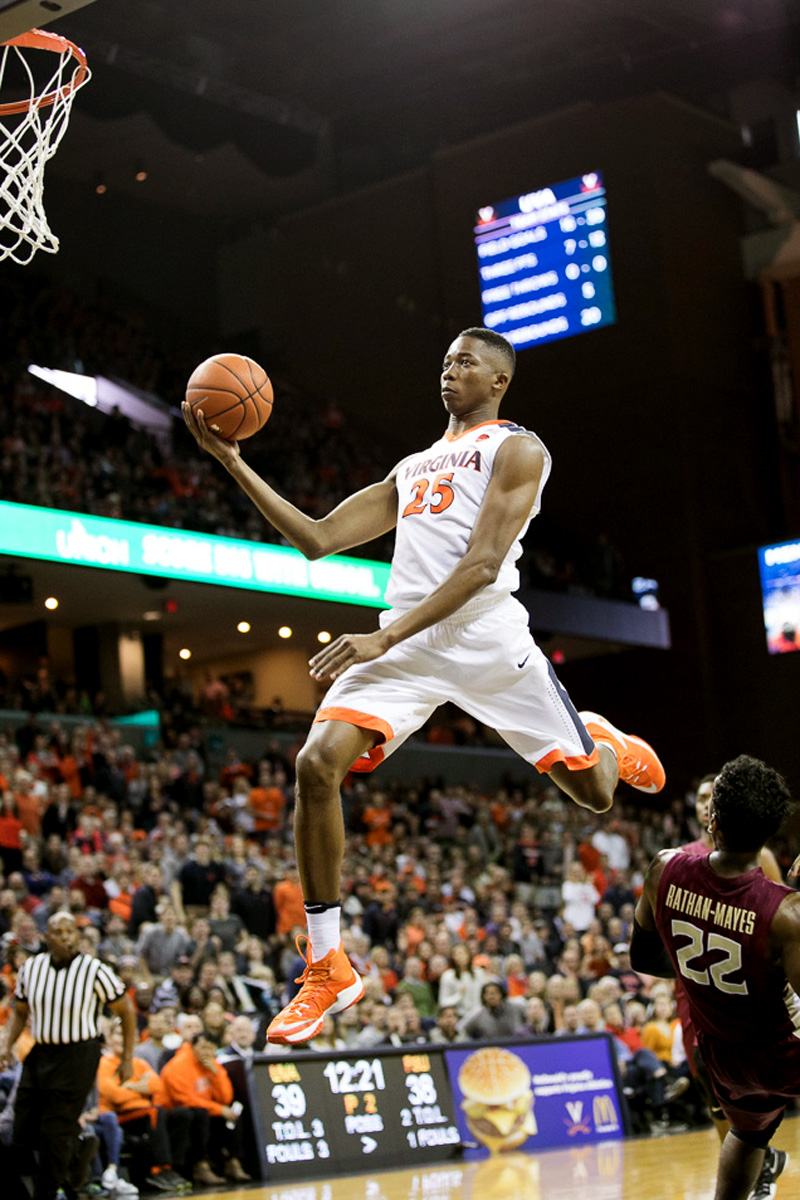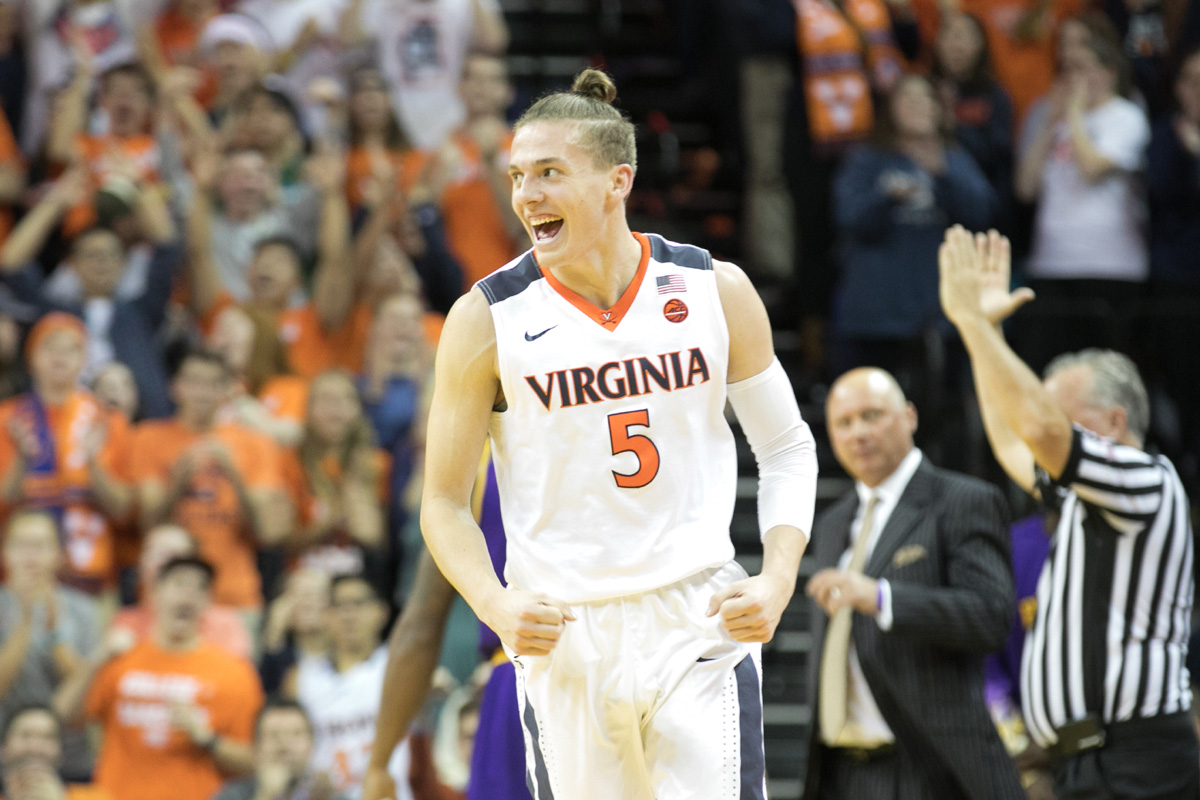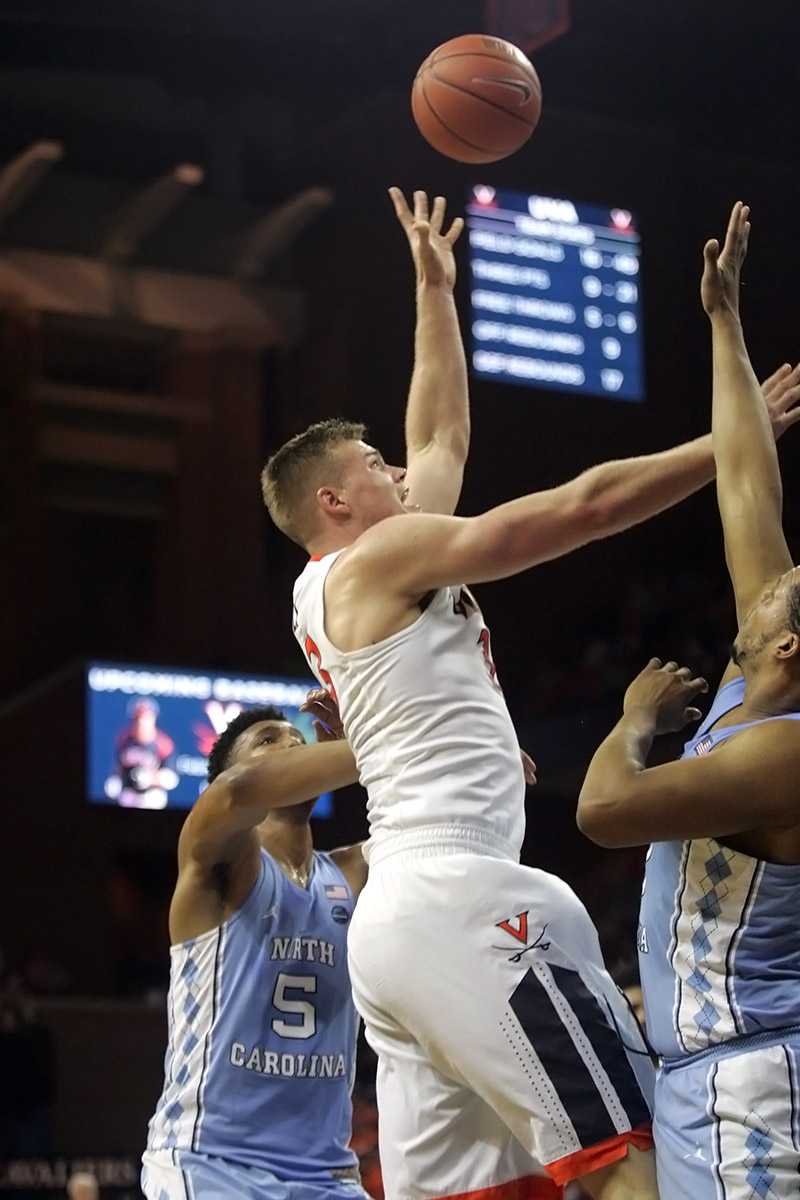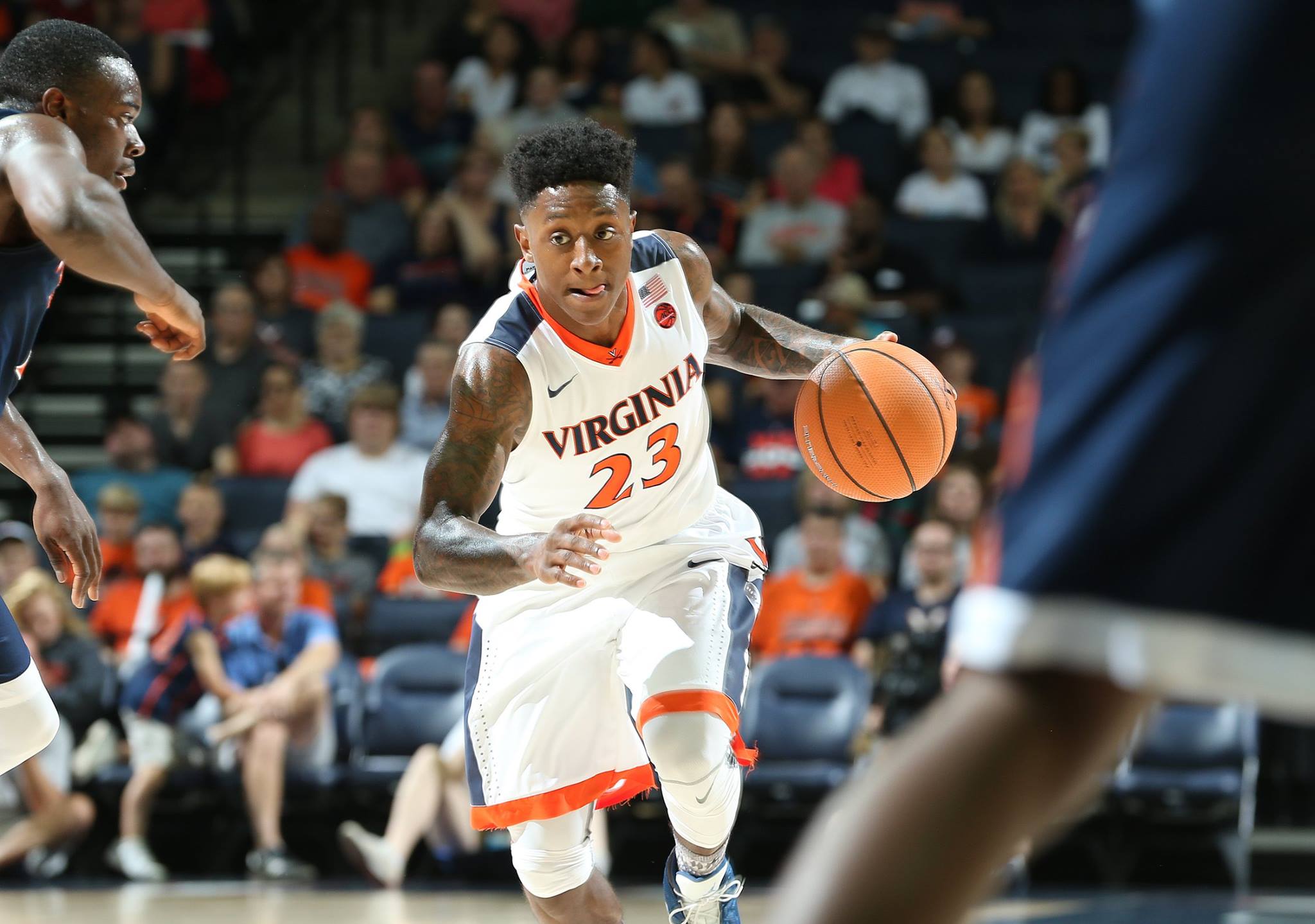
Virginia basketball season is almost here with the season opener less than 48 hours away at the John Paul Jones Arena. Before the Cavaliers host UNC Greensboro at 7 p.m. on Friday, however, it’s time for what has become a preseason tradition on TheSabre.com: 10 questions for Tony Bennett’s Hoos.
This article’s goal is to raise some questions and study some storylines for the season ahead. It’s not meant to be comprehensive, definitive, or revolutionary. Hopefully, it makes you think a little and drives some conversation. Oh, and fun.
The London Perrantes era is over, last season ended on a stinker, the roster looks different than projected after attrition, and the summer recruiting circuit stagnated but there’s as much talent on the roster as ever, Bennett loves the Rocky role, four newcomers could make an impact, and veteran leadership is still strong. With that in mind, let’s dive into what should be an intriguing Virginia basketball season ahead.
10. Can Virginia Create Interior Scoring?
The loss of Anthony Gill and Mike Tobey as they finished their careers ended up having a massive impact on the team’s offense last season once Austin Nichols was dismissed from the program. Without a consistent option to dump the ball down to on the blocks, the offense slowly lost some of its effectiveness over the course of the season. By the time the NCAA Tournament rolled around and Isaiah Wilkins was out with an illness, the Cavaliers needed to make jumpers to survive and even turned to a five-guard lineup in the first round against UNC Wilmington.
Fast forward to this fall and it remains a question mark for the offense. The Hoos add a pair of redshirt freshmen in Jay Huff and De’Andre Hunter – more on them in a moment – that could provide a little bit of post-up opportunities, but both players prefer to face up to do most of their work. Wilkins, Jack Salt, and Mamadi Diakite have worked to add more consistency in the paint as well, but expecting a major transformation there isn’t a likely outcome.
That doesn’t mean this question is a lost cause, though. I believe UVA is going to throw the ball to post players on the blocks more often than last season and encourage them to take more shots. It won’t be as much as with Gill and Tobey, but more and the results likely will vary. Still, the willingness to do that more could open up other things offensively.
Plus, there’s a little word play involved here. Virginia will look for ways to get more interior scoring even if that isn’t exactly post player scoring. I touched on the addition of downhill ball screens and modified spacing in one of the offense’s base sets recently (here and here), but beyond that UVA could give post-up touches to guards like Devon Hall, Ty Jerome, and Hunter too. Plus, transfer Nigel Johnson gets to the rim a little more often than London Perrantes did so that could create points near the basket too.
Will all of that combined lead to more points in the paint? It may not be a back-to-the-basket bonanza, but UVA is going to try to generate more on the interior. If it can, that should help get the offensive efficiency and effectiveness start moving up the charts again.
9. What Role Will The Redshirt Freshmen Play?
De’Andre Hunter and Jay Huff have created an offseason full of daydreaming. The duo spent last season as redshirts, but now they’ll enter the fray as the Wahoos try to make the NCAA Tournament field for the fifth straight year. Both bring unique qualities to the floor, particularly with the departure of three transfers during the offseason. That’s where the daydreaming starts.
Hunter checks in at 6’7” and 222 pounds with a wing span in the seven-foot range. He’s got the build and explosiveness that similar to the ACC wings and forwards that have challenged even UVA’s defense in recent years. He’s essentially plugging into the Marial Shayok slot with more height, more weight, and potentially more versatility.
Hunter can shoot the 3-pointer comfortably, create off the bounce, and work down on the blocks to possibly help the interior scoring question above. Some of the fans’ daydreams grew roots with a social media video that showed Hunter working with Rasheed Wallace on post moves during the offseason. Those variable skills give UVA the option of playing small ball four-guard lineups without actually going all that small due to his height and length, unlike the last two seasons when Malcolm Brogdon and Devon Hall slid over to the power forward role defensively at times.
Huff, meanwhile, may have taken Virginia fans from daydreaming to fantasy land with unicorn talk. That’s the term du jour for players with a lot of size plus a lot of varying skills that makes them unique or rarely seen on the basketball floor. At 7’1” and 230 pounds, Huff fits that mold. He’s essentially plugging into the Jarred Reuter slot with more height, less weight, and potentially more versatility.
Huff can step out and hit 3-pointers, put the ball on the floor to create, post up, play out of the pick-and-roll in any fashion imaginable, and has great touch on free throws. Any of that could help address some of the offense’s late-season efficiency issues from last season. Plus, he created daydreams on loop with a social media video dunking from near the free throw line. Oh, and again, he’s 7’1”.
All of that potential has created some preseason predictions of one or both of those players entering the starting lineup, possibly early or possibly later. I’d focus on something else way ahead of starting predictions, though: consistency. Potential has nothing to do with that. When players can deliver on both ends of the floor night in and night out against college-level competition, then they’ll have a chance to make starter-level impact regardless of when they enter the game.
Virginia coach Tony Bennett has pointed out something along those lines throughout the offseason. Both players have obvious talent. Both players show flashes of high-level ability frequently. Both players still have a long way to go to be the continuous type of players needed on defense and difference makers on offense. So with all of that in mind, their roles at this point are unclear. Both will play significant minutes (12+ minimum?), almost certainly as bench reserves initially. If any sort of consistency shows up during their first year, the role will grow from there.

8. Will 3-Point Volume Climb?
Let’s talk about pace and tempo. After UVA finished last in adjusted tempo and second to last in unadjusted tempo in all of Division I last season, pace of play became a hot topic anew. For Virginia fans, it’s not a matter of aesthetics or effectiveness – the Hoos are doing just fine there thank you – but one of perception and possibilities.
Fans get tired of hearing the TV perception of the program as grinding, slow, and boring. Embrace the pace is a fun slogan, but fans don’t want to feel like they have to defend their team the entire time they’re watching the game. Some fans mute it to get away from it even. Getting out of the bottom spot tempo wise would help a little bit with that. After all, Villanova and Michigan are a two examples of teams that play just five possessions or fewer per game more than Virginia does but those broadcasts don’t spend as much time on words like methodical and deliberate.
That’s where the possibilities part comes in. If that’s the national TV brand being created for the program, is it impacting recruiting? What are travel ball advisors telling players about it? Is that limiting UVA’s recruiting gains? Without talent, big picture dreams of Final Four runs and National Championships are more difficult to attain. Talent is in the eye of the beholder, but there’s still some statistical support for recruiting service ratings and runs in the NCAA Tournament.
All of that can create a tug of war in the world of message boards and the rope is pace. Just a little bit faster tempo could help alleviate some of the concerns from TV broadcasts, to recruiting circles, to fan message boards.
So wait, what does any of that have to do with 3-point volume? Here’s that perception thing again. Remember Villanova and Michigan mentioned above? The Wildcats (43.3%, 31st nationally) and Wolverines (45.1%, 18th nationally) both shoot a lot more 3-pointers than the Cavaliers (33.0%, 252nd nationally). Wisconsin (329th in tempo, 161st in 3-point volume), Cincinnati (325th in tempo, 181st in 3-point volume), and Vanderbilt (300th in tempo, 6th in 3-point volume) fit the list in less extreme ways. Those teams don’t get saddled with pace labels for two reasons: they’re not at the very bottom of the tempo list and the 3-pointer is one of the most exciting shots in basketball.
With all of that said, Virginia isn’t going to change its ways just to shake tempo perceptions even if it might create an uphill climb on the recruiting trail. I think it might happen naturally, though. The personnel (and likely minutes distribution) on this year’s roster is set up for that. Ty Jerome, Kyle Guy, De’Andre Hunter, Jay Huff, and Nigel Johnson seem more likely to take more 3-pointers than their predecessors London Perrantes, Darius Thompson, Marial Shayok, and Jarred Reuter in many of those spots. Just a modest 3% increase in volume would vault UVA up the standings close to 70 spots.
In talking with Coach Bennett this summer, I don’t think 3-point volume growth will be a focus of the offense but when a “good shot” for more players includes the 3-point shot it could increase anyway. It will be interesting to watch and to see how that feeds into the pace conversations.

7. Will Jack Salt’s Contributions Be Better Appreciated?
Redshirt junior center Jack Salt started all 34 games last season and averaged 18.4 minutes per game. He had a huge hand in another NCAA Tournament season and 23 wins too. He did not finish as an All-ACC honoree and found it difficult to stick on the floor against certain lineups or in late-game situations so glancing over Salt’s contributions is something that many observers have done. Some are rushing him out of the starting lineup already despite the fact that his experience, ongoing development, and physicality all play a significant role in UVA’s style of play.
Consider some numbers.
Yes, Salt averaged 3.7 points per game and 4.1 rebounds per game but that doesn’t account for his time on the floor specifically. His per-40 minute stats, checked in at 8.0 points and 8.8 rebounds. His per-100 possessions defensive rating finished at 92.3, which translates to .923 points per possession allowed. Offenses consider 1.0 points per possession as a good number so this is well below that.
Comparing his first year on the floor to his second reveals more. As a full-time rotation player, he increased his per-40 rebounds (+1.8), assists (+0.8), and steals (+0.4), while improving his numbers for field goal percentage (+4.4%) on fewer shots, free throw attempts and percentage (+1.2 and +15.6%), and foul rate (-1.6). His offensive and defensive ratings per 100 possessions did too. While his points per 40 minutes went down (-2.4), that’s steady improvement across the board.
That doesn’t even get into the sort of hidden things Salt brings to the table. He’s arguably one of the best screeners on the team, which is important if you’re running an off-ball screening offense like Virginia does. He does a solid job of preventing rebounds as well even if he isn’t gobbling them all up himself. Plus, there’s just sort of a toughness and attitude he brings to the floor as well – remember him diving out of bounds against Pitt for example?
In some ways, Virginia’s interior scoring issues combined with the expectation that Salt would back up Austin Nichols (plus his All-ACC potential) seem to have watered down what Salt contributed last season. He had a strong year and really a quite impressive improvement year when you get right down to it. It will be interesting to see what his role is this year, but his contributions will be important regardless of how much they’re appreciated.

6. Who is the ‘X’ Factor This Year?
Some years, I comb through the roster to deliberate on this annual question. I bounce back and forth, see two or three potential options, and eventually settle on something. Not this year. My answer is Nigel Johnson.
As the first graduate transfer in the Tony Bennett era, Johnson seems like the obvious choice to me. He was brought in to fill a need for guard depth after the transfers in the spring. He’s going to play and more than likely play a lot. I’ve been forecasting him in the 20+ range out of the gate and nothing I’ve seen or heard so far has changed that starting point.
So Johnson is going to be a piece of the puzzle without question. But what about the ‘X’ Factor piece? I think he could be that on two levels, the macro and micro.
On the big picture level, Johnson could be a huge recruiting tool. If he excels in his lone season as a graduate transfer, that may open the door for more one-year recruits to enter the program at the end of their career, something that might be a need after the 2018 recruiting class cycle. Further, if someone of Johnson’s style – a shorter, quicker guard that can create off the dribble and in some ball screen situations – finds a way to be a productive player in the Virginia system, that could open the eyes of some recruits. That’s been an area that hasn’t panned out often for UVA in recruiting.
For this season, Johnson brings a needed element to the team with the ability to dribble drive into the paint and to provide initial ball pressure on some team’s opposing point guards. Plus, he created 4.5 and 4.8 free throw attempts per 40 minutes over his previous two seasons at Kansas State (2014-15) and Rutgers (2016-17). For context, that’s higher than any guard on the UVA roster last season and close to 4.8-5.0 range Malcolm Brogdon posted his final three seasons. Considering that the Virginia ranked 347th out of 351 teams last season in free throws attempted per field goals attempted, that alone could make him the ‘X’ factor.
Still, that sort of pigeon holes Johnson as a quick guard that drives a lot. He’s more than that as a combo guard that can share ballhandling duties, create for teammates (3.1 assists per 40 last season at Rutgers), and knock down 3-pointers (35% at Rutgers). As a redshirt senior, he brings a lot of experience too so game plans and scouting reports shouldn’t be a learning process. In some ways, he could become a more aggressive version of Darius Thompson perhaps.
There’s one more sort of ‘X’ factor trait too. Johnson has yet to play in the NCAA Tournament and he expressed that was the No. 1 reason he came to Virginia. He knew the chances would be high here for that. That’s going to bring a certain hunger to the program that always can be beneficial. The good news for Johnson, I think, is that he’ll get to satisfy that hunger when March gets here.
Stay tuned for Part II!



